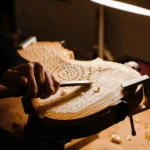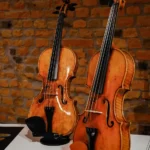Maintaining Your Violin’s Health: The Ultimate Violin Care Guide
Back to BlogTaking good care of your instrument is key to getting the most out of it in the long run, whether you’re looking to increase the value for selling it or want to ensure plenty more years playing a quality instrument. And if you’re not sure where to start when it comes to looking after your violin, you are in the right place! We’ve put together some of our best tips and advice as a violin care guide to help you out.
The Violin Care Guide
The place you live has an impact on your instrument
The humidity and temperature levels affect your instrument and can cause damage without proper care.
The internal wood fibers of a violin can be significantly altered by changing weather, with factors like temperatures and humidity causing the instrument to shift and change.
You should aim to keep relative humidity levels at 50-60% to keep the instrument in good working conditions and produce a quality sound.
To prevent damage caused by dry air, moisten the instrument internally when dry. A specialist string instrument humidifier, such as Dampit, can be used to prevent cracking, split joints, and damage caused by dry air. If the levels are too high, you can leave the violin in the sunlight for a few minutes BUT make sure you do not expose the violin during the hottest hours of the day and leave it out for a maximum of 30 minutes.
Just like you should monitor the humidity levels in the room where the violin is kept, the case where it is stored should also be monitored.
Regular cleaning is crucial.
Cleaning is another important point to look at. After every practice, clean your violin with a dry flannel. This prevents the rosin from bonding with the varnish and sweeps sweat that can sometimes be released while playing. If you are on the team of those that still have rosin bonded with your varnish and it’s been hard to wipe it off, you can try cleaning it with pure turpentine’s essential oil.
String cleaning is also essential! Clean the sweat by rubbing the string with a cloth until it warms up. With use, the strings oxidize with the sweat of the hands that penetrates internally. Changing your strings once in a while is also necessary. As the rosin builds up over time, the strings will become worn, affecting the sound quality of the violin and increasing the risk of string breakage.
Here are some extra tips to keep the strings in optimal conditions: Lubricate with graphite in all the spaces where the strings rest (bridge and nut). Check that the strings are not excessively hollowed into the bridge.
The pegs should be sufficiently fitted and very close to the pegbox cheek.
For a violin to be played well, there must be a set of well-functioning, well-fitted tuning pegs. Over time, the pegs become oval and adhere to only some parts of their orifice, while the ideal position is to embrace it fully.
Wrap the strings around the peg and leave it leaning against the pegbox cheek. This makes the pegs not to jump out when the weather is dry and makes the tuning of the instrument much easier.
Pay close attention to the peg of the A-string; if you always put too much force to put it in place, or if it is poorly adapted, the excess pressure can easily cause a rupture in the pegbox.
Have you checked on the bridge angle?
The bridge must always form a 90º angle with the table. This check can be done by supporting a thin, straight bookmark beside the bridge.
Avoid accidents and unnecessary scratches.
Store your instrument in a high-quality violin case. It is an essential tailor-made cushion for your instrument, reducing the risk of scratches. Your instrument should always be stored away when it is not being used.
Last but not least!
It is always recommended to visit a luthier for a check-up. Just like you visit your doctor, take your instrument to a violin maker or luthier to keep it in perfect condition and for it to be appropriately cleaned and maintained.
The more you learn, the more you can take out from your violin. Keep your violin in shape, and follow us on Instagram for more tips about violins!
Amorim Fine Violins Cremona
An online instrument gallery exhibiting the traditional conception of violin making from the Italian city of Arts. Amorim Fine Violins is a window from Cremona to the world for musicians to find their means of expression.









